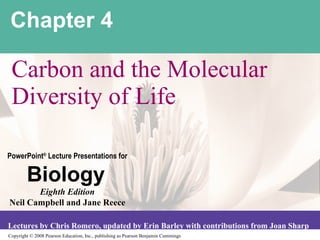
\\D Nashome\Users\G00589026\My Documents\Bio Ch 4 Pwpt
- 1. Chapter 4 Carbon and the Molecular Diversity of Life
- 6. Fig. 4-3 Name Molecular Formula Structural Formula Ball-and-Stick Model Space-Filling Model (a) Methane (b) Ethane (c) Ethene (ethylene)
- 8. Fig. 4-4 Hydrogen (valence = 1) Oxygen (valence = 2) Nitrogen (valence = 3) Carbon (valence = 4) H O N C
- 10. Fig. 4-5 Ethane Propane 1-Butene 2-Butene (c) Double bonds (d) Rings Cyclohexane Benzene Butane 2-Methylpropane (commonly called isobutane) (b) Branching (a) Length
- 12. Fig. 4-6 (a) Mammalian adipose cells (b) A fat molecule Fat droplets (stained red) 100 µm
- 14. Fig. 4-7a (a) Structural isomers 2-methyl butane Pentane
- 15. Fig. 4-7b (b) Geometric isomers cis isomer: The two Xs are on the same side. trans isomer: The two Xs are on opposite sides.
- 16. Fig. 4-7c (c) Enantiomers L isomer D isomer
- 18. Fig. 4-8 Drug Ibuprofen Albuterol Condition Pain; inflammation Asthma Effective Enantiomer S -Ibuprofen R -Albuterol R -Ibuprofen S -Albuterol Ineffective Enantiomer
- 21. Fig. 4-9 Estradiol Testosterone
- 23. Fig. 4-10a Hydroxyl CHEMICAL GROUP STRUCTURE NAME OF COMPOUND EXAMPLE FUNCTIONAL PROPERTIES Carbonyl Carboxyl (may be written HO—) In a hydroxyl group (—OH), a hydrogen atom is bonded to an oxygen atom, which in turn is bonded to the carbon skeleton of the organic molecule. (Do not confuse this functional group with the hydroxide ion, OH – .) When an oxygen atom is double-bonded to a carbon atom that is also bonded to an —OH group, the entire assembly of atoms is called a carboxyl group (—COOH). Carboxylic acids, or organic acids Ketones if the carbonyl group is within a carbon skeleton Aldehydes if the carbonyl group is at the end of the carbon skeleton Alcohols (their specific names usually end in -ol ) Ethanol, the alcohol present in alcoholic beverages Acetone, the simplest ketone Acetic acid, which gives vinegar its sour taste Propanal, an aldehyde Has acidic properties because the covalent bond between oxygen and hydrogen is so polar; for example, Found in cells in the ionized form with a charge of 1– and called a carboxylate ion (here, specifically, the acetate ion). Acetic acid Acetate ion A ketone and an aldehyde may be structural isomers with different properties, as is the case for acetone and propanal. These two groups are also found in sugars, giving rise to two major groups of sugars: aldoses (containing an aldehyde) and ketoses (containing a ketone). Is polar as a result of the electrons spending more time near the electronegative oxygen atom. Can form hydrogen bonds with water molecules, helping dissolve organic compounds such as sugars. The carbonyl group ( CO) consists of a carbon atom joined to an oxygen atom by a double bond.
- 24. Fig. 4-10b CHEMICAL GROUP STRUCTURE NAME OF COMPOUND EXAMPLE FUNCTIONAL PROPERTIES Amino Sulfhydryl Phosphate Methyl A methyl group consists of a carbon bonded to three hydrogen atoms. The methyl group may be attached to a carbon or to a different atom. In a phosphate group, a phosphorus atom is bonded to four oxygen atoms; one oxygen is bonded to the carbon skeleton; two oxygens carry negative charges. The phosphate group (—OPO 3 2– , abbreviated ) is an ionized form of a phosphoric acid group (—OPO 3 H 2 ; note the two hydrogens). P The sulfhydryl group consists of a sulfur atom bonded to an atom of hydrogen; resembles a hydroxyl group in shape. (may be written HS—) The amino group (—NH 2 ) consists of a nitrogen atom bonded to two hydrogen atoms and to the carbon skeleton. Amines Thiols Organic phosphates Methylated compounds 5-Methyl cytidine 5-Methyl cytidine is a component of DNA that has been modified by addition of the methyl group. In addition to taking part in many important chemical reactions in cells, glycerol phosphate provides the backbone for phospholipids, the most prevalent molecules in cell membranes. Glycerol phosphate Cysteine Cysteine is an important sulfur-containing amino acid. Glycine Because it also has a carboxyl group, glycine is both an amine and a carboxylic acid; compounds with both groups are called amino acids. Addition of a methyl group to DNA, or to molecules bound to DNA, affects expression of genes. Arrangement of methyl groups in male and female sex hormones affects their shape and function. Contributes negative charge to the molecule of which it is a part (2– when at the end of a molecule; 1– when located internally in a chain of phosphates). Has the potential to react with water, releasing energy. Two sulfhydryl groups can react, forming a covalent bond. This “ cross-linking” helps stabilize protein structure. Cross-linking of cysteines in hair proteins maintains the curliness or straightness of hair. Straight hair can be “permanently” curled by shaping it around curlers, then breaking and re-forming the cross-linking bonds. Acts as a base; can pick up an H + from the surrounding solution (water, in living organisms). Ionized, with a charge of 1+, under cellular conditions. (nonionized) (ionized)
Hinweis der Redaktion
- Figure 4.3 The shapes of three simple organic molecules
- Figure 4.4 Valences of the major elements of organic molecules
- Figure 4.5 Variation in carbon skeletons
- Figure 4.6 The role of hydrocarbons in fats
- Figure 4.7 Three types of isomers
- Figure 4.7 Three types of isomers
- Figure 4.7 Three types of isomers
- Figure 4.8 The pharmacological importance of enantiomers
- Figure 4.9 A comparison of chemical groups of female (estradiol) and male (testosterone) sex hormones
- Figure 4.10 Some biologically important chemical groups
- Figure 4.10 Some biologically important chemical groups